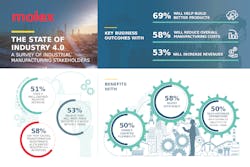With interest in end-to-end connectivity booming, Industry 4.0 has been at the center of discussions pertaining to automation technology and business strategy for several years now. However, despite all the buzz, actual Industry 4.0 implementations are far from ubiquitous, and many hurdles remain for their broader adoption.
In 2019, a survey from industry analyst firm LNS research reported that digital transformation initiatives had already been undertaken by 45% of respondents and another 23% were expecting to begin initiatives within one year. A similar report published by Deloitte in 2018 found that the biggest remaining barrier to mass adoption had less to do with technology and more to do with strategic and operational business issues.
This year, industrial electronics and connectivity technology supplier Molex released an update to its “State of Industry 4.0” survey. The report—part of a series of Molex industry surveys conducted in collaboration with independent research firm Dimensional Research—found that while some progress has been made, many of the key challenges facing Industry 4.0 remain the same.
On the whole, 51% of respondents to the survey indicated that their companies have well-defined Industry 4.0 strategies, marking a modest increase over the findings of LNS Research’s 2019 report. Moreover, Molex’s survey found that executives were significantly more likely to describe their companies’ Industry 4.0 initiatives as well-defined than managers and operations technology (OT) personnel, indicating a continuing disconnect between plant-level operators and enterprise-level planners.
Business Expectations
When it comes to what they would like to achieve through their Industry 4.0 initiatives, 69% of respondents want to build better products, 58% want to reduce overall manufacturing costs, 53% want to increase revenues, 35% want to offer products at a lower price, and 35% want to decrease time-to-market. This is noteworthy from a profitability perspective because it mirrors observations from Deloitte’s 2018 report, which found that while 94% of respondents said the need for digital transformation was an imperative for their business, only 68% expected it to increase profitability. In the case of Molex’s survey, “defensive” interests such as keeping their products competitive similarly take precedence over driving revenue growth.
Regarding implementation timelines, 49% of respondents say they have already achieved major success with Industry 4.0 projects, and 53% believe they will see them within the next two years. However, when asked whether or not the projects will pay off in the next five years or will take more time to fully achieve an adequate return-on-investment, responses were split 50-50, indicating that those surveyed have mixed feelings about whether Industry 4.0 investments can be profitable in the short-term, or are merely mandatory changes required for long-term survival.
Challenges and Barriers
Barriers to adoption cited in the report can be broken down into three primary categories: Cultural challenges, business model challenges, and technology challenges. When asked which type is the most severe, 44% of respondents chose organizational and cultural issues, 33% chose business model issues, and 22% chose technology issues.
On the cultural front, 96% of respondents reported that their customers face challenges that hold back Industry 4.0 implementations, with the biggest being that leadership is more comfortable with traditional approaches and doesn’t advocate for change. In addition, difficulty hiring personnel with the needed data and analytical skills was also cited.
Regarding business model issues, the most prominent was that change is very costly and requires difficult funding decisions. Furthermore, many reported that the large upfront investments required by Industry 4.0 initiatives make achieving a return-on-investment challenging. The prevalence of these concerns may be partially responsible for the explosion in as-a-service and pay-for-performance arrangements increasingly being offered by technology suppliers.
The top technology concerns include separation between information technology (IT) and OT infrastructure, closed or proprietary communication protocols that complicate data transmission, and a lack of cybersecurity protection.
Still, barriers aside, 88% of those surveyed reported being positive about the potential of their Industry 4.0 initiatives going forward. Perhaps even more revealingly, 100% of respondents reported that their organization would benefit from additional Industry 4.0 capabilities, indicating that, even as challenges remain for practical implementation, the idea of Industry 4.0 has been firmly embraced.

